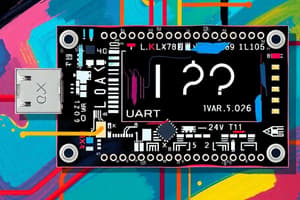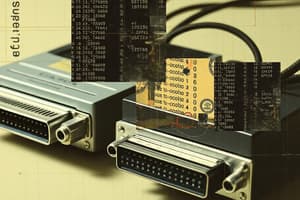Podcast
Questions and Answers
What is the purpose of the JNB RI instruction in the serial communication process?
What is the purpose of the JNB RI instruction in the serial communication process?
- To start timer 1
- To load the SCON register with the value 50H
- To monitor the RI flag bit (correct)
- To clear the RI flag bit
What is the effect of setting the SMOD bit in the PCON register?
What is the effect of setting the SMOD bit in the PCON register?
- It changes the serial mode to mode 0
- It increases the baud rate of data transfer (correct)
- It clears the RI flag bit
- It decreases the baud rate of data transfer
What is the purpose of the RI flag bit in the serial communication process?
What is the purpose of the RI flag bit in the serial communication process?
- To indicate the start and stop bits of a character
- To indicate the reception of an entire character (correct)
- To indicate the end of a character transmission
- To indicate the start of a character transmission
What is the difference between interrupts and polling in microcontrollers?
What is the difference between interrupts and polling in microcontrollers?
What is the function of the SCON register in the serial communication process?
What is the function of the SCON register in the serial communication process?
What is the purpose of the CLR RI instruction in the serial communication process?
What is the purpose of the CLR RI instruction in the serial communication process?
What is the purpose of the SCON register in 8051 microcontroller?
What is the purpose of the SCON register in 8051 microcontroller?
Which register in the 8051 microcontroller is responsible for framing data with start and stop bits before transmission over the TxD line?
Which register in the 8051 microcontroller is responsible for framing data with start and stop bits before transmission over the TxD line?
What happens when a byte data is written into the SBUF register in 8051 microcontroller?
What happens when a byte data is written into the SBUF register in 8051 microcontroller?
What is the function of the SBUF register in the 8051 microcontroller when data is received via the RxD line?
What is the function of the SBUF register in the 8051 microcontroller when data is received via the RxD line?
In serial communication with the 8051 microcontroller, what task is done by the 8051 when data is received via the RxD line?
In serial communication with the 8051 microcontroller, what task is done by the 8051 when data is received via the RxD line?
What is the significance of the SCON register's settings concerning serial communication in the 8051 microcontroller?
What is the significance of the SCON register's settings concerning serial communication in the 8051 microcontroller?
What is the purpose of start and stop bits in asynchronous serial data communication?
What is the purpose of start and stop bits in asynchronous serial data communication?
How many bits do start and stop bits consist of in asynchronous communication?
How many bits do start and stop bits consist of in asynchronous communication?
What is the role of the start bit in serial communication?
What is the role of the start bit in serial communication?
In block-oriented data transfers, what method is generally used?
In block-oriented data transfers, what method is generally used?
What is the measure of data transfer rate in serial data communication?
What is the measure of data transfer rate in serial data communication?
What do baud rate and bps refer to in serial communication?
What do baud rate and bps refer to in serial communication?
Flashcards are hidden until you start studying
Study Notes
UART and USART
- UART stands for Universal Asynchronous Receiver-Transmitter
- USART stands for Universal Synchronous-Asynchronous Receiver-Transmitter
Asynchronous Serial Data Communication
- Widely used for character-oriented transmissions
- Each character is placed in between start and stop bits, known as framing
- Start bit is always one bit, but the stop bit can be one or two bits
- Start bit is always 0 (low) and the stop bit(s) is 1 (high)
Data Transfer Rate
- Measured in bits per second (bps)
- Baud rate is a modem terminology and is defined as the number of signal changes per second
- In modems, a single change of signal can transfer several bits of data
Serial Communication in 8051 Microcontroller
- SCON register is used to control data transfer through TXd and RXd pins
- SCON register is loaded with the value 50H to indicate serial mode 1, where an 8-bit data is framed with start and stop bits
- TR1 is set to 1 to start timer 1
- RI flag bit is monitored to see if an entire character has been received
- When RI is raised, SBUF has the byte, and its contents are moved to a safe place
Doubling Baud Rate
- Two ways to increase the baud rate:
- Using a higher frequency crystal
- Changing a bit in the PCON register
- PCON register is an 8-bit register
- SMOD bit in PCON register can be set to high by software to double the baud rate
Interrupts
- Interrupts: a device notifies the microcontroller by sending an interrupt signal, and the microcontroller interrupts its current task to serve the device
- Interrupt service routine (ISR) or interrupt handler is the program associated with the interrupt
- Polling: the microcontroller continuously monitors the status of a given device
8051 Serial Port
- Synchronous and Asynchronous serial communication modes
- Four modes of operation: Mode 0, Mode 1, Mode 2, and Mode 3
- SCON register is used to control data transfer through TXd and RXd pins
Registers related to Serial Communication
- SBUF register: an 8-bit communication register used solely for serial communication
- SCON register: used to control data transfer through TXd and RXd pins
- PCON register: an 8-bit register used to control the baud rate
Studying That Suits You
Use AI to generate personalized quizzes and flashcards to suit your learning preferences.




